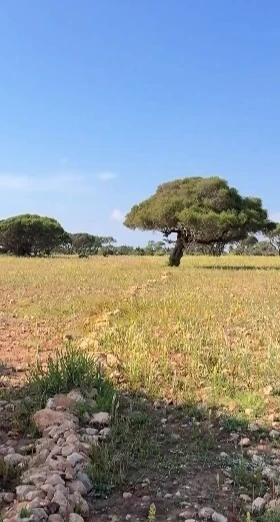

We find ourselves in the UNESCO Biosphere Reserve of southwestern Morocco – in the land of argan trees. Argania spinosa grows endemically only here, in a narrow strip between Essaouira and Agadir. A gnarled, centuries-old tree species, perfectly adapted to the arid climate, strong winds, and intense sunlight.
The argan tree belongs to the sapodilla family and can live up to 200 years. Its roots reach deep into the soil and help prevent erosion – an invisible but vital function in this dry region.
The famous climbing goats in the treetops searching for fruits, and dromedaries that don't shy away from the thorny branches, are part of a finely tuned natural balance.
However spectacular this looks – for oil production, the fruits are no longer obtained through animal digestion. Instead, they are collected by hand today to ensure the highest quality standards.
In autumn, the ripe fruits fall to the ground naturally. They are collected, dried, and carefully opened to access the inner kernels. These are extremely hard – almost like carob seeds – and protect the actual target: the oil-containing seed inside.
Traditionally, the kernels are ground with heavy granite mills from the Atlas Mountains. This creates a thick paste from which the oil is pressed – by hand or in modern hydraulic presses.
The result is a gold-colored oil with a nutty aroma, highly valued both in cooking and cosmetics. Argan oil contains over 80% unsaturated fatty acids as well as large amounts of vitamin E and antioxidants.
In Morocco, it is traditionally women who produce argan oil. Since the 1990s, numerous cooperatives have been established where women earn a regular income – many of them for the first time in their lives.
These cooperatives play a central role not only in the economic development of the region but also in preserving the tree population. As the international value of the oil grows, the argan tree is protected, cared for, and replanted.
Argan oil is a true Moroccan cultural asset. In 2010, it received the status of a protected designation of origin ("Appellation d'Origine Protégée") – similar to champagne or Parma ham in Europe.
This means: Only oil obtained from fruits of argan trees in the official growing area and processed according to traditional methods may call itself "genuine argan oil."
This landscape is shaped by the nearby Atlantic Ocean. The humid sea breezes provide a surprisingly mild climate – rarely above 26 degrees Celsius even in summer. This special microclimate makes the survival of argan trees possible in the first place.
What appears dry and hostile at first glance is in reality a sensitive ecosystem – rich in knowledge, history, and future.
The argan tree is more than just a raw material supplier. It symbolizes resilience, lived knowledge, and nature's intelligent adaptation to extreme conditions.
A place seemingly out of time. And an impressive example of what is possible when humans and nature live in harmony – and listen to each other.